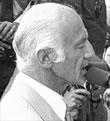FOR PRESS: MR. WHITLAM's ECONOMIC FANTASIES
Statement by the Prime Minister, the Rt. Hon. William
r. icMahon, l^. P.
The latest excursion by the Leader of the Labor
Party into economic fantasy and downright inaccuracy illustrate
his complete ignorance of financial principles and facts.
His claim that ne would double national production
in ten years is as ill-considered as his recent declaration
that he would re-value the Australian dollar now, completely
ignoring the damage that would do to our great rural,
manufacturing and mining industries.
It is obvious that Rr. hitlamr. is seeking office by
making promises which he cannot keep, especially against the
background of his Party's declared economic policies and
intentions. The frustrations of being so long in opposition
have led the Labor Party to present irresponsible, grab-all
proposals that would certainly damage the economy beyond
repair. Mr. Whitlam says that a Labor Government would aim
for growth of six to seven percent per year. This is an
astonishingly ambitious target for him, with his policies.
In fact his own election promises would clearly prevent him
achieving his policies. What is worse, they would actually
depress growth. Take their 35 hour week and extended annual leave
proposals. These must reduce output per man that is
productivity, on which growth depends so heavily.
Then there is immigration. In the past this has done
much for national growth. It has enabled employers to find
labour for many development projects and to recruit particular
skills which would otherwise be unavailable. Labor would
reduce immigration and what is more, it would cease Government
recruiting. This vould mean there would be no selection on the
basis of skill. Here again the national economy would suffer.
./ 2
-2
A growth of six or seven percent has not been
achieved in the past in Australia over more than a very short
period and Mr. Whitlan has not indicated what steps Labor
would take to step up growth other than introduce indicative
planning. But comprehensive indicative planning would require
a significant diversion of manpower from other urgent tasks.
Indicative planning involves target setting and targets which
turn out to be unrealistic -and many must be are worse than
useless. When efforts and resources are devoted to trying to
make thle facts of economic life fit the plans the result is
likely to be reduced rather than enhanced growth.
1M1r. Whitlam falsely says that Australia's growth
rate in the 1960' s was less than 3 percent. The facts are that
Australia's growth rate in the 1960' s was about 5h percent a
year. He also ignored the fact that inflation has eased.
The consumer price index has been rising at 7 percent, but so
far this year it has declined to around 5 percent.
Both these rates of increase in prices are below
what was experienced in the immediate postwar years and
unemployment has been well below the peak of 1961.
Mr. Whitlan also falsely represented the September
quarter figures on growth. Hc said thc: increase was only
.3 percent. While this was the increase estimated in G. N. P.
at constant prices, the figure was sharply affected by a
set-back in the farm sector caused by drought. This is
temporary. The significant figure was that non-farm G. N. P.
at constant prices grew in the September quarter at an annual
rate of 4 percent. It is the Government Partics' objective to obtain
thle maximum growth1* rate our economy can sustain and we have
proved that we can bc successful.
We know our policies and programmes can and will
achieve maximum growth. We also know that Labor could not do
this, on the evidence of Mr. Whitlam's own economic fallibility.
Mr. Whitlam was reported as saying that based on
calculations by the Mielbourne University's Institute of Applied
Economic and Social Research, the growth rate would need to
reach 6 percent to eliminate unemployment next year.
What he has failed to realise is that growth of this
order from now on is, in fact, implicit in the Government's
expectations that G. N. P. at constant prices will increase in
1972/ 73 as a whole by 5 percent. / 3
-3
But such growth is predicated on the fact that
sound economic policies are followed. If -Mr. Vhitlam's
policies are followed, the very basis of our growth would,
as I have said, be completely destroyed.
The Australian economy is buoyant, unemployment is
at a low level, inflation has eased and the growth rate is
increasing. Personal taxation has been reduced significantly
and the tax scales have been restructured. That is the true
state of affairs today. Hore are the facts in brief.
Inflation The consumer price index hias dropped from an annual
rate of 7 percent to 5 percent.
Employmcnt There were 82,400 persons out of a work force of
million registercd for employment last month. This is
1.46 percent of the work force a figure accepted as close
to full employment and one of the best in t%-hc world. In other
words, around 98.5 percent of the work force is gainfully
employed. Prospects for school-leavers are excellent.
Consumer Demand Retail spending us up 12 percent compared with
8 percent last year.
Building Dwelling approvals are rising very strongly and
seasonally adjusted, are at a record level. The total value
of all building approved in September was the second highnest
figure ever recorded.
Growth A grOw~ th rate of better than 5 percent in real termsnot
3 pcercent as Wgnitlam claims has in fact been achieved
in recent years. We are approaching that level again after the recent
temporary setback to the cconomy.
CANBERRA, 27 November, 1972

